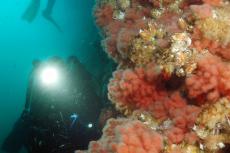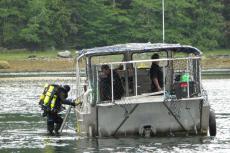Technical Diving Paradise In Pacific NW
I often raise a few eyebrows when I exclaim, “I’ll take diving in the Pacific Northwest over anyplace else in the world.” And it’s true.
The drift diving is unmatched, complimented with a rich diversity of unique marine life including wolf eels, giant Pacific octopus, and six-gill sharks. Although recreational diving opportunities are also unsurpassed, technical diving is equally as good throughout the Pacific Northwest.
So what makes this area one of the best technical diving hotspots in the world? I personally am partial to our deep 300-foot walls adorned with ancient sponges and populated by immense lingcod and healthy schools of rockfish. But my real passion lies in the opportunity to explore such a selection of very different deep wrecks, few have seen. Many of these wrecks often attract technical divers from around the world for exploration, research, or just the challenge of facing our temperate environment. Whatever the reason, the Pacific Northwest seems to fully accommodate a technical diver’s needs.
Although many tech sites in the Pacific Northwest are easily accessible from the shore, most of the choice sites require a boat for access. Browning Wall near Port Hardy on Vancouver Island in British Columbia (BC) is a local favorite and arguably one of the best dives on the Pacific Coast for any level of certified diver!
You can easily spend an entire dive trying to find a single square meter of rock not adorned with red soft corals or yellow bread-of-crumb sponge. This current-bathed wall stretches from the surface down to 73 meters (240 feet), where we often find 20-25 centimeter (8-10 inch) tall pink and white gorgonian sea fans intermingled with the other soft corals, anemones, and basket sea stars.
At this point the ocean floor slopes off into deeper water with little to see. I like to dive the deepest parts of the wall with Trimix, but extended range and decompression procedure-trained divers can pick their depth based on their comfort level.
Two other popular deep walls are; beneath the power lines in Agamemnon Channel and at Whytecliff Park, both in BC. Agamemnon Channel is located on the Sunshine Coast, north of Horseshoe Bay and the town of Sechelt. Here, we find huge yellow and white cloud sponges starting at 15 meters (50 feet) and 1.2 meter (4-foot) high red gorgonian sea fans at 56 meters (185 feet). The deeper you go the bigger the gorgonians get, but watch your depth, as this wall bottoms out around 182 meters (600 feet)!
Underwater photographers also enjoy this dive because it hosts an array of different rockfish. You can often find juvenile yellow-eye rockfish hiding in the cloud sponge openings and along the rocky terrain. Adult tiger rockfish are very colourful and quillback rockfish bravely hold their ground.
The wall at Whytecliff Park is popular among shore divers for parking, entry/exits and proximity to town. The wall is reached after swimming through a protective cove, where it stair steps down to well over 122 meters (400 feet). Cloud sponge, giant white plumose anemones, and the occasional tanner (snow) crab are often found here along with schools of rockfish.
Whytecliff Park is also a popular picnic area—a great place to bring the whole family. So, when diving here on weekends, make sure to arrive early for parking. The wall is a short walk down a paved road and then a relatively short swim from the shore.
Historical sites
While the marine history of the Pacific Northwest isn’t as lengthy as the East Coast’s, nor did our coast have the maritime military action of World War II, we still have a good selection of technical diving shipwrecks. But what sets us apart from the eastern US coast and the rest of the world are the extensive training sites we have.
British Columbia has four retired Canadian Destroyer Escorts (111 meters/366 feet in length) for both recreational and technical divers to enjoy. Add to this a 53-meter (175 foot) freighter, a 30-meter (100 foot) tugboat, a 122-meter (400 foot) Victoria-Class ship (equivalent to a US Liberty Class ship), and a 737 jet plane, all within recreational depths, and you have an endless playground to explore or train on!
These artificial reefs are commonly used by serious wreck divers to stage practice penetration dives and learn in a semi-controlled environment. With outside entry to almost all deck levels, depths range from about 26 meters (85 feet) on the main decks to over 42 meters (140 feet) within the belly of the HMCS Cape Breton. For those looking to challenge their skills, the HMCS Chaudiere is located in Sechelt Inlet positioned on its side. This provides a different and often disorienting perspective when penetrating.
Unfortunately, none of the natural wrecks in Washington State or British Columbia are accessible from shore, but most are only a short boat ride from a local port of call. My favorites in BC include the wreck of the MV Gulf Stream, a 44-meter (147-foot) vessel with its bow at 33 meters (110 feet) and the stern in approximately 50 meters (165 feet), near Dinner Rock off Powell River. Visibility is often excellent, particularly at depth. While the Gulf Stream can be done on air, a light Trimix makes the dive more enjoyable. ....
(...)
Download the full article ⬇︎

Originally published
X-Ray Mag #33
Solomon Islands by Steve Jones :: Amos Nachoum - Great White Dive :: Oman - Desert Diving by Charles Stirling : Scotland's Sounds of Mull & Oban by Steve Jones :: The Canadian Tech Trail by Barb Ron & Ron Akeson :: Diving Moscow River :: The latest Buoyancy Control Devices :: Wide angle photography :: Paddlewheel steamer found in the Canadian sub-Arctic ::


































